
INTRODUCTION
Never lose touch with what’s going on with this handy device:
stayed tuned to your favorite radio station or listen for the
latest weather warnings.
Equipped with an emergency siren, flashlight and ability to
charge your mobile phone, this Multi-Powered Emergency
Radio is a must-have item for your outdoor adventures.
Keep this manual handy as you use your new product. It
contains practical step-by-step instructions as well as technical
specifications and warnings you should know about.
NOTE This product is specifically equipped for access to
NOAA Weather Radio, but it does not have an alert function
when weather warnings occur. For alert features, please
consider our WR202 or WR203 models with Alert and SAME
Alert functionality.
ABOUT THE NATIONAL WEATHER RADIO SYSTEM
The National Weather Service (NWS) is an agency within
the National Oceanic & Atmospheric Administration (NOAA)
that operates a nationwide network of radio stations known
as the NOAA Weather Radio (NWR). The NWR radio system
broadcasts warning information for all types of hazards, both
natural and technological. Working in conjunction with the
Emergency Alert System (EAS), NWR is an all-in-one hazards
radio network and is considered to be the single source of all
comprehensive weather and emergency information.
A nationwide network, the NWR consists of more than 1000
stations in the United States, Puerto Rico, the US Virgin
Islands and US Pacific Territories. Broadcasts are designed
to meet local needs. Routine programming is repeated
every few minutes and consists of local forecast, regional
conditions and marine forecasts.
Additional information, including river stages and climatic
data, is also provided. During emergencies, these routine
broadcasts are interrupted to report specific warnings.
OVERVIEW
FRONT VIEW
1. VOL knob: turn on / off radio; adjust volume
2. : turn emergency alarm on/off
3. Solar panel
4. MODE switch: select radio (AM / FM), National Weather
Radio (NWR channels 1-7) or mobile phone charging
5. Crank: wind to charge battery or mobile phone
6. LED indicator:red light to indicate unit / mobile phone is
charging or green light to indicate radio is on
Multi-Powered Emergency Radio
Model:WR201
USER MANUAL
BACK VIEW
1. turn flashlight on/off
2. TUNING: adjust radio frequency (AM / FM only)
3. Antenna
4. Light
5. Mobile phone charger jack
6. Headphone jack
7. DC adapter jack
POWER SOURCE
This Multi-Powered Emergency Radio has a built-in
rechargeable battery that can store energy from different
sources: a solar panel, a manual hand crank, or electricity
via an adapter (not included in package).
IMPORTANT AM/FM radio and NOAA radio do not function
when battery is low. Promptly recharge battery to prevent
disruptions to broadcasts or playing of music.
Insert rechargeable battery:
1. Using a screwdriver, remove screw from battery
compartment cover and lift cover away.
2. Insert battery pack (with cylinders lying sideways).
3. Align holes in the connector with the pins, then push
connector in.
4. Tuck wires in and ensure they are within the battery
compartment area.
5. Close battery compartment cover and secure with screw.
SOLAR POWER
Expose the solar panel directly to sunlight.
TIPS
• For best results when charging the battery, place the
solar panel directly with view to sunlight.
• Direct solar panel as follows:
Solar panel facing: if you reside in the:
North Southern
Hemisphere
South Northern
Hemisphere
• It takes approximately 18 hours to fully charge the
battery by solar power (under strong light conditions).
• Do not scratch the solar panel’s surface or wipe it with
strong detergent.
• Do not expose the solar panel to rain, snow or moisture.
• The duration of the rechargeable battery’s charging or
operating time is determined by either the intensity of
sunlight or the position of the solar panel towards the sun.
• Do not overcharge the batteries.
NOTE Solar panel cannot be used to charge mobile phone.
EN
CRANK
IMPORTANT
Wind crank at a steady rate of at least 2
revolutions per second. To indicate the phone is receiving
enough power to charge, a red LED will light up. Continue
cranking at this rate until you feel your mobile phone has
been adequately charged. The red LED will be lit for the
duration of the charging process.
If for any reason cranking was stopped, wait at least
5 seconds before beginning to crank again.
Damages to your mobile phone and/or battery may result
from not following these instructions for which Oregon
Scientific disclaims any liability. Oregon Scientific will not
be held liable for any actual or consequential damages
arising from this.
Mobile phones can only be charged by cranking or by
adapter (separate purchase required).
To charge unit:
1. Slide MODE switch to any position other than .
2. Lift crank and wind clockwise.
To charge mobile phone:
1. Using USB cable (not included) connect one end to
the mobile phone and the other end to mobile phone
charger jack.
2. Slide
MODE switch to select .
3. Lift crank and wind clockwise.
NOTE 1 minute of winding can power the radio for approx.
10 minutes. It would take approximately 50 minutes of
continuous winding (2 turns per second) to fully charge
the battery.
NOTE Some smartphone models may not charge using
the crank and the USB slot in this product. Please test this
function using your phone to ensure that it works with your
product. You may also want to consider charging an external
battery pack as a backup for emergencies.
ELECTRICITY FROM ADAPTER
To use this feature, purchase a 5V adapter.
1. Lift the soft plastic cover located on the back of the unit.
2. Plug adapter into the unit and the other end to wall outlet.
3. Slide
MODE switch to or any other position
depending on what you intend to charge.
NOTE It takes 2.5 hours to fully charge the battery by using
a charger, that is not included.
AM/FM RADIO
NOTE When battery is low, radio cannot be turned on.
To turn radio on / off and adjust volume:
• Turn VOL knob.
Green light indicates radio is on.
NOTE When charging, even if radio is on, indicator light
will be red.
To select frequency:
1. Slide MODE switch to select AM or FM.
2. Turn
TUNING wheel to adjust frequency.
TIP Reception quality may vary; try positioning in various
locations. If using the unit indoors, reception will improve as
you get closer to windows or upper rooms of your residence
or location. Be sure to extend the antenna to improve
reception as well.
NOAA WEATHER RADIO
FINDING LOCAL CHANNELS
National Weather Service uses one of 7 preset radio
frequencies for their NOAA Weather Radio transmitters
across the country. Please refer to the below phone
number and website link to find the right channel for your
local county:
To contact the NWS by telephone:
1. Phone 1-888-NWR-SAME (1-888-697-7263).
2. Follow prompts through a simple voice menu.
To obtain NWS radio channels on the internet:
1. Locate www.nws.noaa.gov/nwr/indexnw.htm
2. Click the State for which information is needed.
For example, clicking on “Montana” will give a list of
information relevant to the State of Montana including the
names of counties, NWR transmitter locations, the frequency
of the transmitter, the strength of the signal in WATTS, and
any remarks as applicable.
Example of the first 10 county radio channels:
COUNTY NWR
FREQ CALL CHOOSE
TRANS- MHZ RADIO
MITTER CHANNEL
Beaverhead
Butte,MT 162.550 WXL79 7
Beaverhead
Dillon,MT 162.475 WNG638 4
Big Horn Billings,MT 162.550 WXL27 7
Blaine Havre, MT 162.400 WXL53 1
Blaine Billings MT 162.475 WWG85 4
Broadwater Helena, MT 162.400 WXK66 1
Carbon Billings MT 162.550 WXL27 7
Carter Baker, MT 162.550 WXK57 7
Cascade Great Falls, 162.550 WXJ43 7
MT
Chouteau Miles Hill, MT 162.500 WWG84 5
After identifying the frequency of your local NOAA
Weather Radio transmitter, refer to below table to find the
corresponding channel (1-7).
To receive weather alerts, slide the
MODE switch to select
the NOAA weatherband channel (WB 1-7) for your area.
Examples of which radio to choose for a particular location
is given in the far right column in above chart.
CHANNEL CORRESPONDING
RADIO FREQUENCY
1 162.400 MHz
2 162.425 MHz
3 162.450 MHz
4 162.475 MHz
5 162.500 MHz
6 162.525 MHz
7 162.550 MHz
NOTE When battery is low, NOAA radio cannot be
turned on.
RECEPTION TEST
The fact that you can get clear voice reception does not
guarantee that an emergency alert will trigger your unit’s
alert tone. To test actual reception, your unit must receive
a test or emergency alert signal broadcast. Try positioning
the radio in different locations to find a place where it can
receive a clear signal to ensure its effectiveness.
The National Weather Service (NWS) broadcasts a test
alert every week on Wednesday between 10AM and 12PM
(noon). To receive the test message make sure that a
Channel has been selected.
To find out the specific test schedule in your area, contact
your local National Oceanic and Atmospheric Administration
(NOAA) or National Weather Service (NWS) office. These
offices are usually listed in the telephone book under
“US Government”.
If you have any questions regarding alarm tests or to verify
if a test was conducted, contact the programming office of
your local NOAA Weather Radio station.
EMERGENCY SIREN
This emergency radio is equipped with a siren to help you
call the attention of passersby should you be in distress or
encounter an emergency situation.
To turn emergency alarm on:
Push switch outward.
To turn alarm off, push
switch back to its
original position.
FLASHLIGHT
Press to turn flashlight on / off.
SPECIFICATIONS
TYPE DESCRIPTION
Dimensions
(L x W x H)
6.3 x 1.8 x 3.0 inches
(160 x 45 x 77 mm)
Weight
10.9 oz (308 g)
AM radio 520 – 1710 KHz
FM radio 88 – 108 MHz
NOAA radio
162.400 - 162.550 MHz
Battery 350mAh 3.6V Ni-MH
rechargeable battery
DC adapter DC5V 500mA (not includ)
PRECAUTIONS
• Do not subject the unit to excessive force, shock, dust,
temperature or humidity.
• Do not cover the ventilation holes with any items such
as newspapers, curtains etc.
• Do not immerse the unit in water. If you spill liquid over
it, dry it immediately with a soft, lint-free cloth.
• Do not clean the unit with abrasive or corrosive materials.
• Do not tamper with the unit’s internal components. This
invalidates the warranty.
• Only use fresh batteries. Do not mix new and old batteries.
• Images shown in this manual may differ from the
actual display.
• When disposing of this product, ensure it is collected
separately for special treatment and not as household waste.
• Placement of this product on certain types of wood
may result in damage to its finish for which Oregon
Scientific will not be responsible. Consult the furniture
manufacturer's care instructions for information.
• The contents of this manual may not be reproduced
without the permission of the manufacturer.
• Do not dispose old batteries as unsorted municipal
waste. Collection of such waste separately for special
treatment is necessary.
• Please note that some units are equipped with a
battery safety strip. Remove the strip from the battery
compartment before first use.
• Should there be any discrepancies between the English
and other language versions, the English version shall
apply and prevail.
NOTE The technical specifications for this product and
the contents of the user manual are subject to change
without notice.
NOTE Features and accessories will not be available in
all countries. For more information, please contact your
local retailer.
ABOUT OREGON SCIENTIFIC
Visit our website (www.oregonscientific.com) to learn more
about Oregon Scientific products.
For any enquiry, please contact our Customer Services at
info@oregonscientific.com
.
FCC STATEMENT
This device complies with Part 15 of the FCC Rules. Operation
is subject to the following two conditions: (1) This device may
not cause harmful interference, and (2) This device must
accept any interference received, including interference that
may cause undesired operation.
WARNING Changes or modifications not expressly
approved by the party responsible for compliance could void
the user’s authority to operate the equipment.
NOTE This equipment has been tested and found to comply
with the limits for a Class B digital device, pursuant to Part
15 of the FCC Rules. These limits are designed to provide
reasonable protection against harmful interference in a
residential installation.
This equipment generates, uses and can radiate radio
frequency energy and, if not installed and used in accordance
with the instructions, may cause harmful interference to
radio communications. However, there is no guarantee
that interference will not occur in a particular installation. If
this equipment does cause harmful interference to radio or
television reception, which can be determined by turning the
equipment off and on, the user is encouraged to try to correct
the interference by one or more of the following measures:
• Reorient or relocate the receiving antenna.
• Increase the separation between the equipment
and receiver.
• Connect the equipment into an outlet on a circuit different
from that to which the receiver is connected.
• Consult the dealer or an experienced radio / TV
technician for help.
INTRODUCTION
Ne perdez jamais le contact avec ce qui se passe autour
de vous grâce à cet appareil très pratique: restez à l’écoute
de votre station radio favorite ou écoutez les alertes météo
en cours.
Equipée d’une sirène d’alarme, d’une lampe torche et de
la capacité de recharger votre téléphone portable, cette
Radio à Alimentation Multiple pour situations d’urgence est
l’accessoire indispensable de vos aventures de plein air.
Gardez cette notice à portée de main quand vous utilisez ce
nouveau matériel. Elle contient des instructions pratiques
détaillées ainsi que les caractéristiques techniques et les
avertissements que vous devriez connaitre.
REMARQUE Cet appareil est équipé spécifiquement pour
l’accès au réseau de Radio Météo NOAA, mais il n’a pas
de fonction d’alerte quand des alertes météo se produisent.
Pour les fonctions d’alerte, veuillez considérer nos modèles
WR202 ou WR203 avec fonctions d’alerte standard et
d’alerte SAME.
A PROPOS DU RÉSEAU NATIONAL DERADIO MÉTÉO
Le service Météorologique National (NWS) est une
agence qui fait partie de l’Administration Nationale
Océanique & Atmosphérique (NOAA) qui gère un réseau
national de stations radio connu comme Radio Météo
NOAA (NWR). Le système de radio NWR diffuse des
informations d’alerte concernant tous types de dangers,
soit naturels, soit technologiques. En conjonction avec le
Système d’Alertes d’Urgence (EAS), NWR est un réseau
intégré pour tous les risques et est considéré comme
source unique de toute l’information complète sur la météo
et les alertes d’urgence.
Étant un réseau national, NWR est constitué de plus
de 1000 stations aux États-Unis, à Porto Rico, aux Iles
Vierges Américaines et dans les territoires américains du
Pacifique. Les émissions sont conçues pour répondre aux
besoins locaux. Un programme de routine est répété à
quelques minutes d’intervalle et comprend des prévisions
locales, les conditions météo régionales et les prévisions
météo marines.
De l’information supplémentaire, y compris les niveaux
des rivières et les données climatiques, est également
fournie. En cas d’urgence, ces émissions de routine sont
interrompues pour diffuser des alertes spécifiques.
VUE D’ENSEMBLE
VUE AVANT
1. VOL : bouton pour allumer / éteindre la radio et régler
le volume
2. : allumer / éteindre la sirène d’alarme
3. Panneau solaire
4. MODE: interrupteur pour sélectionner la fréquence radio
(AM / FM), la Radio Météo Nationale (NWR canaux 1-7)
ou le chargement de téléphone portable
5. Manivelle: à remonter pour charger la batterie ou un
téléphone portable
6. Voyant LED: le voyant rouge indique que l’appareil ou le
téléphone portable est en train d’être chargé, le voyant
vert indique que la radio est en marche
Radio à Alimentation Multiple pour
situations d’urgence
Modèle : WR201
NOTICE D’UTILISATION
VUE ARRIÈRE
1. Allume / Éteint la lampe torche
2. TUNING: ajuste la fréquence radio (AM / FM seulement)
3. Antenne
4. Lampe
5. Prise de chargement de téléphone portable
6. Prise de casque
7. Prise d’adaptateur courant continu
SOURCE D’ALIMENTATION
Cette Radio à Alimentation Multiple pour situations d’urgence
a une batterie rechargeable qui peut entreposer l’énergie
de sources différentes : un panneau solaire, une manivelle
ou de l’alimentation électrique par un adaptateur (qui n’est
pas inclus).
IMPORTANT la radio AM/FM et la radio NOAA ne
fonctionnent pas quand les piles sont faibles. Recharger
les piles promptement pour éviter les interruptions des
émissions ou de l’écoute de musique.
Insertion de la batterie rechargeable :
1. Avec un tournevis, dévisser la vis du compartiment à
batterie et enlever le couvercle.
2. Insérer le bloc batterie (la partie cylindrique positionnée
parallèlement à la radio).
3. Aligner les trous de connexion avec les broches et
enfoncer le connecteur.
4. Ranger les fils soigneusement pour s’assurer qu’ils sont
à l’intérieur du compartiment à batterie.
5. Refermer le couvercle du compartiment à batterie et le
verrouiller avec la vis.
ALIMENTATION SOLAIRE
Exposer le panneau solaire directement à la lumière
du soleil.
ASTUCES
• Pour de meilleurs résultats quand vous rechargez la
batterie, placer le panneau solaire en vue directe
du soleil.
• Diriger le panneau solaire comme suit :
Le panneau solaire
fait face au :
Si vous résidez dans:
Nord L’Hémisphère Sud
Sud L’Hémisphère Nord
• Il faut environ 18 heures pour charger la batterie
complètement par alimentation solaire (avec un
ensoleillement fort).
• Ne pas rayer la surface du panneau solaire ou le
nettoyer avec un détergent puissant.
• Ne pas exposer le panneau solaire à la pluie, la neige
ou l’humidité.
• La durée de chargement de la batterie rechargeable ou
le temps d’utilisation sont déterminés soit par l’intensité
de l’ensoleillement, soit par la position du panneau
solaire par rapport au soleil.
• Ne pas charger la batterie excessivement.
REMARQUE Le panneau solaire ne peut pas être utilisé
pour charger les téléphones portables.
FR
DECLARATION OF CONFORMITY
The following information is not to be used as contact for support
or sales. Please visit our website at www.oregonscientific.com
for all enquiries.
We
Name: Oregon Scientific, Inc.
Address: 19861 SW 95
th
Ave.,Tualatin,
Oregon 97062 USA
Telephone No.: 1-800-853-8883
declare that the product
Product No.: WR201
Product Name: Multi-Powered Emergency Radio
Manufacturer: IDT Technology Limited
Address: Block C, 9/F, Kaiser Estate,
Phase 1, 41 Man Yue St.,
Hung Hom, Kowloon,
Hong Kong
is in conformity with Part 15 of the FCC Rules. Operation is
subject to the following two conditions: 1) This device may
not cause harmful interference. 2) This device must accept
any interference received, including interference that may
cause undesired operation.
WR201_M_ EN FR ES R7.indd 1 8/30/12 10:12:54

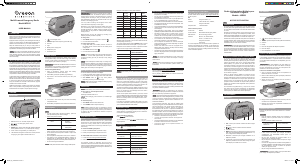


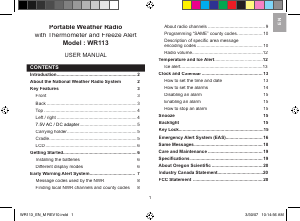
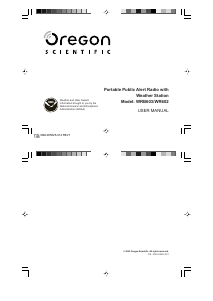
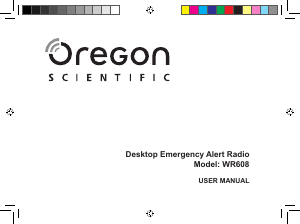
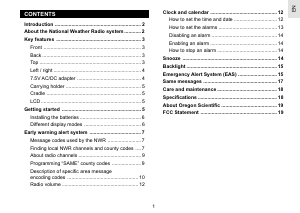
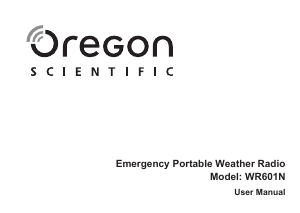


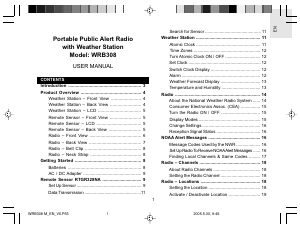
Praat mee over dit product
Laat hier weten wat jij vindt van de Oregon WR201 Radio. Als je een vraag hebt, lees dan eerst zorgvuldig de handleiding door. Een handleiding aanvragen kan via ons contactformulier.